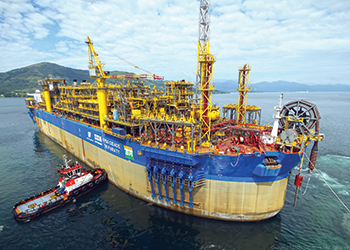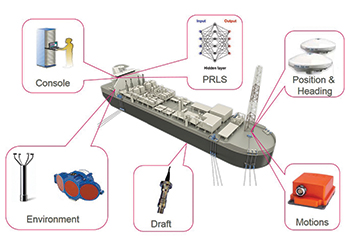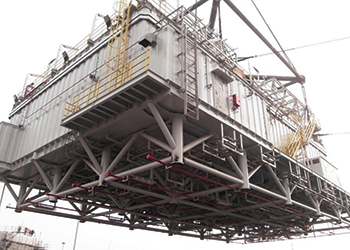
 FPSOs ... challenges ahead
FPSOs ... challenges ahead
The oil price fall and the completion of a wave of projects in the next two years will change the dynamics of the market and growth will fall subsequently. However, the market will continue to attract spending for the next 10 years, says a report
Floating production, storage and offloading (FPSO) vessels are a competitive solution for the development of offshore oil fields. This is especially the case when exploration and production (E&P) operations are performed in challenging environments and marginal fields where alternative infrastructure, such as oil pipelines, are insufficient or would require excessive capital investment in order to be completed.
With the rate of new onshore discoveries at a historic low and technology enabling exploration in unprecedented depths, production in deepwater and ultra-deepwater has gained the spotlight in the oil industry. Demand for new-build and converted FPSO vessels have benefitted from this trend. The oil price fall and the completion of a wave of projects in the next two years will change the dynamics of the market and growth will fall subsequently. However, the market will continue to attract significant spending for the next 10 years, as long as oil prices are high enough to warrant investment.
Visiongain calculates that global capex on new build and converted FPSO units will be $8,655 million in 2015, in Visiongain’s anticipated oil price scenario. The South American and West African regions will see the highest investments due to their recent ultra-deepwater discoveries in the pre-salt basins. However, other regions also have potential, such as Southeast Asia, as more countries strive to balance diminishing onshore output with the development of new offshore reservoirs.
FPSO market, as per the report, is expected to grow at 12 per cent compound annual growth rate (CAGR) by 2019, adding that FPSO technology is considered the most suitable technology for oil production in deepwater and extreme climatic conditions.
Global FPSO market 2015-2019 report says advances in technology improves oil recovery techniques. These advances include unlocking the potential of processing oil and gas in harsh temperatures and pressures through the use of floating production systems (FPS) and methods to separate oil at the production facility instead of separating it at the hub.
Advanced FPSOs can also mitigate harsh environment conditions because they use turret mooring with self-adjusting stiffness systems, which makes mooring in shallow water easier. Also, in adverse weather conditions, the turret of an FPSO can sink beneath the waves and can be reconnected later. In addition, global FPSO market vendors are increasing their investment in research and development (R&D), which is expected to reduce the time and risks associated with production processes. The overall volume of production will increase, whereas the costs and risks will decline significantly because of rapid advances in technology.
The huge energy demand requires operators to search for reserves in remote deep and ultra-deepwater locations, which involves coping with harsh environments and associated.
According to the report on FPSO market, in recent years, maturing onshore oil reserves have triggered a shift from onshore to offshore reserves such as deepwater and ultra-deepwater reserves to increase oil and gas production. Currently, subsea production activities are growing because of the depleting oil reserves worldwide. Production levels of oil and gas worldwide will likely rise significantly on the back of a sharper focus on oil recovery in offshore reserves. This will not only help to improve the current supply-demand imbalance prevailing in the market, but also stabilise volatile oil prices.
The global FPSO market can be segmented into two divisions based on application: shallow water and deep and ultra-deep water. The following companies are the key players in the global FPSO market: BW Offshore, Chevron, CNOOC, ExxonMobil and Petrobras. Other prominent vendors in the market are: Modec, SBM Offshore and Total. The report states that the increased deployment of FPSO is having an adverse impact on the environment in terms of increased hydrocarbon emissions resulting from production operations, light and noise pollution, emissions from flare stacks and fuel combustion, routine discharges into the marine environment, and waste disposal.
Worst to come for FPSOs: However, this year may not be promising for new FPSO contracts as the corruption scandal engulfing Petrobras and weak oil prices are likely to discourage oil companies from going ahead with final investment decisions, says IHS Petrodata in a recent report.
IHS Petrodata believes that only five FPSOs would be awarded this year. Of these, two, the Ghana FPSO and the South Pars FPSO projects, have been awarded. So there’re just three left for this year, it says in the report.
IHS Petrodata says: "The year 2015 is shaping out to be a dreadful year for FPSO awards. Petrobras, the world’s biggest FPSO buyer, is embroiled in a corruption probe that may affect its ability to contract for FPSOs in 2015. Volatile oil prices will also limit FPSO demand, as operators may postpone investment decisions until oil prices improve or until further cost savings are achieved."
SBM Offshore, a major FPSO leaser, is already preparing for lower demand after announcing 1,200 job cuts in December 2014.
Eni, an Italian oil and gas company, awarded the $2.54 billion Ghana FPSO contract to Malaysian offshore oilfield service provider, while Petroiran Development Company (Pedco) has ordered an FPSO for the South Pars field in offshore Iran.
Recent oil price volatility is likely to reduce FPSO orders in 2015. Maersk Oil, Premier Oil, and Chevron have already postponed final investment decisions for their proposed FPSO projects, citing low oil prices.
In the case of Premier Oil, it has postponed FID for the Vette and Sea Lion FPSO projects, while Maersk Oil and Chevron have put their Chissonga and Gehem and Gendalo FPSO projects on hold.
Energy Maritime Associates, which also analyses the floating production sector, concurs that little FPSO investment activity is anticipated in the next two quarters as oil companies continue to reduce development spending. The consultancy thinks that should oil prices drop below USD60 per barrel, then only one more FPSO could be awarded this year.
Energy Maritime Associates MD David Boggs says: "Without new orders in 2015 a few companies, particularly yards in China, will see an idle period with no floating production work. The downturn that already swept through the exploration sector is now just starting to hit the production market."
IHS Petrodata is, however, optimistic that Brazil’s desire to quickly exploit its oil resources would override weak oil prices.
IHS Petrodata says: "South American FPSO demand should improve from 2016 onwards. A closer look at 2009 FPSO awards suggests that Petrobras will still be a major buyer in a period of oil price weakness, as the national oil company is focused on rapid development of Brazil’s oil production. In 2009, Petrobras was the only operator to order 2 large FPSOs (P-63 and Cidade de Anchietta) despite a plunge in oil prices. Petrobras also said in January 2015 that its pre-salt projects were profitable at an oil price of $45 per barrel.






































































